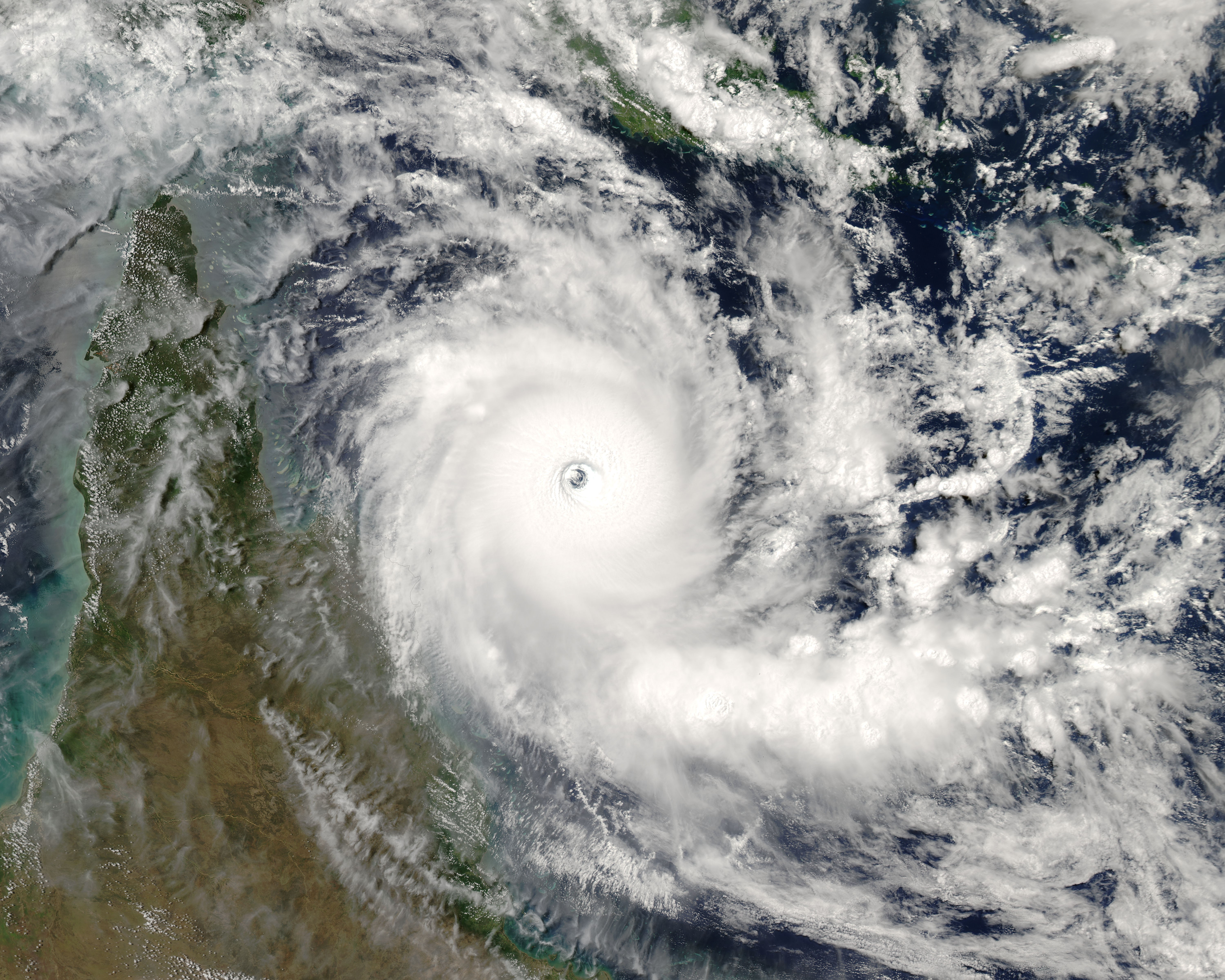Cyclone hazard
A probabilistic hazard assessment of strong winds from tropical cyclones was conducted at a worldwide level. Hazard for both strong winds and storm surge was assessed using as input historical tropical cyclones from five different oceanic basins: Northeast Pacific, Northwest Pacific, South Pacific, North Indian, South Indian and North Atlantic.
Completeness periods were calculated for each basin to determine the occurrence frequency of historical cyclones. For each historical track, a family of one-hundred associated “children” tracks was obtained using a bi-dimensional Wiener process.
Strong winds speed and storm surge run-up was calculated for each cyclone child track and the results were used to compute probability moments of wind speed and coastal run-up for each historical track. The results are expressed, for the strong winds, in terms of the geographical distribution of the peak wind speed of 3-seconds gusts, and for the storm surge, as the distribution along the shorelines of the maximum surge run-up and its associated flooding. In both cases, intensities are modeled as random variables with a Gamma distribution. This analysis was repeated for all historical cyclones. The hazard assessment result is the set of probabilistic wind fields and storm surge floods.
Surge hazard
The model indeed includes the future projections of sea level rise and since the storm surge hazard occurs in the presence of tropical cyclones it in fact considers the extraordinary waves generated by the cyclone on the affected coasts.
There is a storm surge model for both the baseline climate and two alternative climate change scenarios and risk assessment was performed for all three cases. We attach the dataset for storm surge considering climate change.
The storm surge hazard maps, available in the platform, are not used in the risk computations. The risk assessment methodology uses a collection of stochastic scenarios (AME file), which includes all the possible ways in which said phenomenon may affect the region of analysis, in terms of its frequency and severity. The hazard maps, on the other hand, are a representation of the expected intensity value (in this case storm surge run-up height) for different return periods and are obtained from the AME file.
More information on the model can be found in:
Cardona O.D., Ordaz M.G., Mora M., Salgado-Gálvez M.A., Bernal G.A., Zuloaga-Romero D., Marulanda M.C., Yamín L. and González D. (2014). Global risk assessment: a fully probabilistic seismic and tropical cyclone wind risk assessment. International Journal of Disaster Risk Reduction. 10:461-476.
Cardona, O.D. et al. (2015). Update on the Probabilistic Modelling of Natural Risks at Global Level: Global Risk Model - Global Earthquake and Tropical Cyclone Hazard Assessment. Disaster Risk Assessment at Country Level for Earthquakes, Tropical Cyclones (Wind and Storm Surge), Floods, Tsunami and Volcanic Eruptions. CIMNE & INGENIAR Consortium, Barcelona & Bogota.
Inputs:
- Recorded hurricane tracks
- Topography
- Ground roughness
- Bathymetry of the coastline
Outputs:
- Wind intensities map
- Surge intensities map

Exposure
exposed elements database
- Georeferenced location
- Infrastructure component
characterization, material, height length, construction system
- Infrastructure indicators
Population served, national socioeconomic indicators
Inputs:
- Georeferenced infrastructure elements data
- National indicators
- Population census
Outputs:
- Infrastructure elements database
Vulnerability
The vulnerability of infrastructure components is defined using mathematical functions that relate the intensity to the direct physical impact. Such functions are called vulnerability functions and they must be estimated and assigned for each one of the components identified, and for each hazard considered. Vulnerability functions provide the variation of the probability moments of the relative loss with increasing intensity (see Figure below).
Vulnerability functions allow the transformation from the occurrence of a hazard event and the local intensities caused by it, to quantification of direct losses on the exposed elements.
Inputs:
- Vulnerability functions for each class of exposed elements
- Hazard intensity measure
Outputs:
- Relative damage [%]
Risk
The proposed fully probabilistic risk assessment considers multiple events of multiple hazards, which implies the simulation of thousands of possibilities in which those hazards may manifest, under future changing climates. For each simulated event, the damage to the infrastructure system is quantified through the vulnerability functions. Repeating this process for different hazard events results in different damages simulated for the same infrastructure, each rendering some economic loss with a probability of occurrence. Typically, low damage events have a higher probability of occurrence, which means they are more frequent, and high damage events have lower probabilities or are less frequent (see Figure below). This collection of loss amounts and probabilities makes up a truly probabilistic and multi-hazard risk assessment of any infrastructure system. This process will be applied to all infrastructure sectors country-by-country
Illustration of the calculation of loss in an event-based probabilistic risk assessment
Although disaster risk is fully quantified by the set of losses, it is more practical to express it as condensed metrics that summarize the results into curves or point estimates. Two of the most widely used metrics are the Probable Maximum Loss (PML) curve and the Average Annual Loss (AAL).
The PML curve describes the variation of losses to the return period. It fully integrates all the consequences, even of different hazards, to define the feasibility that large loss amounts occur sometime in the future.
On the other hand, the AAL is a multi-annual loss average, like an insurance premium, i.e., it quantifies an annual loss that, in the long term, accumulates to the total amount of losses that will be caused by disasters to the infrastructure. It is a multi-hazard metric as well.
Inputs
- Hazard (Wind speed and surge depth)
- Exposed elements database (classified by portfolio)
- Vulnerability (by exposed element class)
Outputs
Risk metrics:
- Loss Exceedance Curve (LEC)
- Average Annual Loss (AAL)
- Probable Maximum Loss (PML)
- Risk maps

